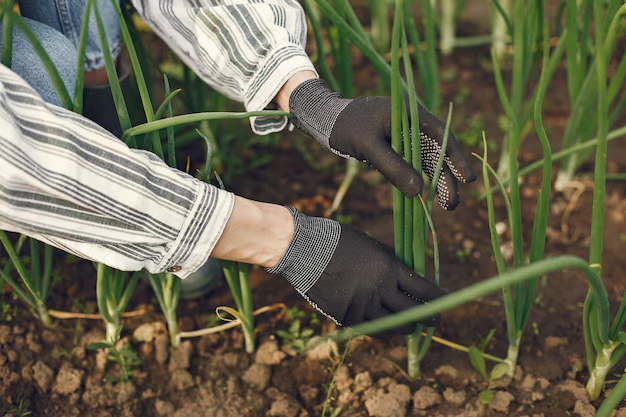Garlic is a fantastic crop for both novice and experienced gardeners. However, beginner gardeners often make several mistakes when growing garlic, which can hinder their plant’s growth and yield. In this article, we’ll delve into the most common garlic gardening mistakes to avoid for beginners and share practical tips to help you cultivate healthy and bountiful garlic. Whether you’re planting garlic for the first time or have had limited success in the past, this guide will help you make smarter gardening decisions.
Choosing the Wrong Garlic Variety
One of the first steps in successful garlic gardening is selecting the right variety. Garlic varieties are broadly categorized into two types: hardneck and softneck. Softneck varieties are ideal for mild climates, while hardneck varieties thrive in colder regions.
Mistake: Many beginners fail to choose the appropriate variety for their climate, leading to poor growth and low yields.
Solution: Before planting garlic, ensure you choose the correct type based on your local climate. Hardneck garlic is more robust and flavorful, making it perfect for colder zones, while softneck garlic is great for warmer regions.
Planting Garlic at the Wrong Time
Timing plays a significant role in garlic growth. Garlic requires a long growing season and needs to be planted at the right time of year to establish roots before winter.
Mistake: Beginners often plant garlic too early or too late, leading to delayed sprouting and weak bulbs.
Solution: In most regions, the best time to plant garlic is in the fall, around 4–6 weeks before the first hard frost. This allows the garlic to establish strong roots. In warmer climates, garlic can also be planted in late winter or early spring.
Not Preparing the Soil Properly
Garlic requires well-drained, nutrient-rich soil to grow successfully. Beginners may overlook soil preparation, resulting in garlic plants that struggle to develop healthy bulbs.
Mistake: Planting garlic in compacted or nutrient-poor soil.
Solution: Garlic thrives in loamy, well-drained soil that is rich in organic matter. Before planting, improve the soil by adding compost or well-rotted manure. Consider performing a soil test to ensure it has the right pH (between 6.0 and 7.0) for garlic.
Overcrowding Garlic Plants
Garlic needs space to grow its bulbs. If garlic is planted too close together, the plants will compete for nutrients and space, resulting in smaller bulbs and poor yields.
Mistake: Planting garlic cloves too close to each other.
Solution: Space garlic cloves 6–8 inches apart in rows that are about 12–14 inches apart. This allows each plant enough space to develop into a healthy bulb.
Ignoring Watering Needs
Garlic requires consistent moisture, especially during the early stages of growth. However, it’s also important not to overwater, as garlic is prone to root rot.
Mistake: Inconsistent watering, either overwatering or underwatering, leading to poor bulb development.
Solution: Garlic needs regular watering but requires good drainage to avoid standing water. Aim to keep the soil consistently moist but not soggy, particularly during the growing season. Mulching around the plants can help retain moisture.
Failing to Mulch
Mulching is an essential step for protecting garlic from the elements and maintaining consistent soil moisture.
Mistake: Skipping mulch or using improper mulch material.
Solution: Apply a 2–4 inch layer of mulch (such as straw or leaves) over your garlic bed after planting. This will help retain moisture, suppress weeds, and protect the garlic from temperature fluctuations.
Harvesting Too Early or Too Late
Timing your garlic harvest is crucial for ensuring the bulbs are fully mature. Harvesting too early results in underdeveloped bulbs, while harvesting too late can cause the cloves to separate prematurely.
Mistake: Harvesting garlic before it’s fully mature or waiting too long to pull it from the ground.
Solution: Garlic is ready to harvest when the lower leaves begin to yellow and die off, but the upper leaves are still green. Gently pull the garlic bulbs out of the ground and allow them to dry in a shaded, well-ventilated area.
Not Rotating Crops
Planting garlic in the same spot year after year can lead to soil depletion and the buildup of disease-causing pathogens.
Mistake: Planting garlic in the same location without rotating crops.
Solution: Rotate garlic with other crops every 2–3 years to prevent disease and maintain soil fertility. This also helps break the cycle of pests that target garlic.
Using Store-Bought Garlic for Planting
Store-bought garlic is often treated with chemicals to prevent sprouting and may not be suited for your growing conditions.
Mistake: Using supermarket garlic for planting, which may not produce good results.
Solution: Purchase certified seed garlic from reputable sources. These garlic varieties are guaranteed to be free from diseases and pests, ensuring a better yield.
Neglecting Pest and Disease Management
Garlic can be susceptible to a variety of pests and diseases, including aphids, root rot, and rust. Beginners may not recognize these early signs of damage.
Mistake: Failing to monitor for pests and diseases, leading to crop loss.
Solution: Regularly inspect your garlic plants for pests and diseases. Use organic pesticides or neem oil to treat infestations, and ensure good air circulation to prevent fungal diseases.
Comparison Chart: Common Garlic Gardening Mistakes
| Mistake | Impact | Solution |
| Choosing the wrong variety | Poor growth and low yield | Select hardneck for cold climates, softneck for warm climates |
| Planting at the wrong time | Delayed sprouting, weak bulbs | Plant in fall, 4–6 weeks before frost or early spring |
| Not preparing the soil properly | Weak bulbs, poor growth | Use well-drained, nutrient-rich soil with proper pH |
| Overcrowding plants | Small bulbs, poor yield | Space cloves 6–8 inches apart, rows 12–14 inches apart |
| Inconsistent watering | Root rot or underdeveloped bulbs | Water consistently, avoid overwatering, ensure drainage |
| Skipping mulching | Weed growth, moisture loss | Apply 2–4 inches of organic mulch to retain moisture |
| Harvesting too early or too late | Underdeveloped or prematurely separated bulbs | Harvest when lower leaves yellow, but top leaves are green |
| Not rotating crops | Soil depletion, increased disease risk | Rotate garlic with other crops every 2–3 years |
| Using store-bought garlic for planting | Poor yield, potential disease spread | Buy certified seed garlic from reputable sources |
| Neglecting pest and disease management | Crop loss, stunted growth | Regular pest checks, use organic treatments if needed |
Conclusion:
Growing garlic can be a rewarding experience, but avoiding common gardening mistakes is crucial to achieving the best results. By following the tips and solutions outlined above, you can improve your chances of growing healthy, flavorful garlic. Remember that patience is key, as garlic requires time and care to grow properly. With the right knowledge and approach, your garlic garden will thrive.











